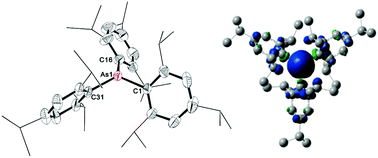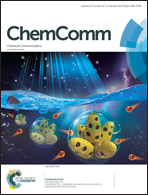Syntheses, structures and theoretical calculations of stable triarylarsine radical cations†
Abstract
The first stable triarylarsine radical cation salts 1˙+[BArF4]− and 2˙+[BArF4]− were afforded by one-electron oxidation of triarylarsines Trip3As (1, Trip = 2,4,6-iPr3C6H2) and Dipp3As (2, Dipp = 2,6-iPr2C6H3) with AgSbF6 and NaBArF4 (ArF = 3,5-(CF3)2C6H3), respectively. Their molecular and electronic structures were investigated by single-crystal X-ray diffraction, electron paramagnetic resonance (EPR) and UV-vis absorption spectroscopy, in conjunction with density functional theory (DFT) calculations. The EPR and computational results demonstrate that the spin density of 1˙+ and 2˙+ is mainly distributed on the As nuclei.

- This article is part of the themed collection: Philip Power at 65: an icon of organometallic chemistry


 Please wait while we load your content...
Please wait while we load your content...